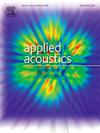Design and performance analysis of bidirectional vibration ultrasonic transducer for wire bonding
IF 3.4
2区 物理与天体物理
Q1 ACOUSTICS
引用次数: 0
Abstract
Ultrasonic frequency, amplitude and vibration mode are the key factors affecting the stability and reliability of ultrasonic wire bonding. Conventional wire bonding is realized by ultrasonic transducer (UT) with single frequency and longitudinal vibration. To optimize the bonding process and achieve high-performance bonding joints, we propose an UT that utilizes two longitudinal vibration and one bending vibration mode, which realized by the full PZT and regional polarization PZT. By employing a step-type flexible structure, the flanges for three vibration modes are optimized at the same node position. To drive the UT, the amplifier module circuit with 39.98 times amplification and 130 kHz bandwidth is designed. Under the 9 kg·cm torque for assembling UT, the longitudinal vibration frequencies of the UT are 71.2 kHz and 122.9 kHz, and the bending vibration frequency is 43.1 kHz. The self-developed amplifier module is designed to drive the UT for both single and coupled vibration, and the test results show that the amplitude of the bending vibration is 7.49 µm at a driving voltage of 20 V, and the amplitudes of the 1st longitudinal vibration and the 2nd longitudinal vibration are 5.72 µm and 4.44 µm, respectively, which satisfy the amplitude requirements for wire bonding. Furthermore, the coupled vibration trajectory of the UT forms a parallelogram, and the vibration area can be adjusted by changing the amplitude. Experimental results have shown that the bending mode is excited by regionally polarized PZT, achieving sufficient vibration in both x/y directions while ensuring a small and lightweight structure. This provides a potential application solution for the new bonding method of wire bonding.
金属键合用双向振动超声换能器的设计与性能分析
超声频率、振幅和振动方式是影响超声焊线稳定性和可靠性的关键因素。传统的金属丝键合是通过单频纵向振动的超声换能器实现的。为了优化键合工艺,实现高性能的键合接头,我们提出了一种利用两种纵向振动和一种弯曲振动模式的UT,通过全PZT和区域极化PZT来实现。采用阶跃式柔性结构,在同一节点位置对三种振动模式的法兰进行优化。为了驱动UT,设计了放大39.98倍、带宽130khz的放大模块电路。在9 kg·cm装配扭矩下,UT的纵向振动频率为71.2 kHz和122.9 kHz,弯曲振动频率为43.1 kHz。设计了自主开发的放大模块,对UT进行单振动和耦合振动驱动,测试结果表明,在20 V驱动电压下,弯曲振动幅值为7.49µm,第一次纵向振动幅值为5.72µm,第二次纵向振动幅值为4.44µm,满足线键合的幅值要求。此外,UT的耦合振动轨迹形成平行四边形,并且可以通过改变振幅来调节振动区域。实验结果表明,由区域极化PZT激发弯曲模态,在保证结构体积小、重量轻的同时,在x/y两个方向上都实现了充分的振动。这为金属丝键合的新型键合方法提供了一种潜在的应用解决方案。
本文章由计算机程序翻译,如有差异,请以英文原文为准。
求助全文
约1分钟内获得全文
求助全文
来源期刊

Applied Acoustics
物理-声学
CiteScore
7.40
自引率
11.80%
发文量
618
审稿时长
7.5 months
期刊介绍:
Since its launch in 1968, Applied Acoustics has been publishing high quality research papers providing state-of-the-art coverage of research findings for engineers and scientists involved in applications of acoustics in the widest sense.
Applied Acoustics looks not only at recent developments in the understanding of acoustics but also at ways of exploiting that understanding. The Journal aims to encourage the exchange of practical experience through publication and in so doing creates a fund of technological information that can be used for solving related problems. The presentation of information in graphical or tabular form is especially encouraged. If a report of a mathematical development is a necessary part of a paper it is important to ensure that it is there only as an integral part of a practical solution to a problem and is supported by data. Applied Acoustics encourages the exchange of practical experience in the following ways: • Complete Papers • Short Technical Notes • Review Articles; and thereby provides a wealth of technological information that can be used to solve related problems.
Manuscripts that address all fields of applications of acoustics ranging from medicine and NDT to the environment and buildings are welcome.
 求助内容:
求助内容: 应助结果提醒方式:
应助结果提醒方式:


